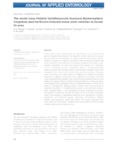Por favor, use este identificador para citar o enlazar este ítem:
http://www.alice.cnptia.embrapa.br/alice/handle/doc/1073867| Título: | The social wasp Polybia fastidiosuscula Saussure (Hymenoptera: Vespidae) uses herbivore-induced maize plant volatiles to locate its prey. |
| Autor: | SARAIVA, N. B.  PREZOTO, F.   FONSECA, M. das G.   MORAES, M. C. B.   BORGES, M.   LAUMANN, R. A.   AUAD, A. M.   |
| Afiliación: | N. B. Saraiva, UFJF; F. Prezoto, UFJF; M. das G. Fonseca; MARIA CAROLINA BLASSIOLI MORAES, Cenargen; MIGUEL BORGES, Cenargen; RAUL ALBERTO LAUMANN, Cenargen; ALEXANDER MACHADO AUAD, CNPGL. |
| Año: | 2017 |
| Referencia: | Journal of Applied Entomology, v. 141, p. 620-629, 2017. |
| Descripción: | Social wasps in the Polybia genus are important for use as pest-control agents in agricultural systems. The objective of this study was to investigate the behavioural responses of Polybia fastidiosuscula Saussure (Hymenoptera: Vespidae) to volatiles from maize, both constitutive volatiles and those induced by the herbivory of Spodoptera frugiperda (JE Smith) (Lepidoptera: Noctuidae). To assess the behavioural response of P. fastidiosuscula to S. frugiperda larvae, undamaged plants, S. frugiperda-damaged plants, mechanically damaged plants, mechanically damaged plants plus regurgitant from larvae and extracts from various treatments, bioassays were conducted in a Y-olfactometer. In addition, the volatiles from plants subjected to different treatments were collected via aeration, and they were quantified and identified. The wasps showed a greater preference for plants with damage induced either by larval feeding or by being mechanically damaged plus regurgitant than for undamaged plants or either larvae alone or mechanically damaged plants. Wasps were more attracted to extracts from plants + S. frugiperda larvae and to an extract from mechanically damaged plants + the regurgitant of larvae compared to hexane. The primary compounds induced by herbivory for 5?6 h after the beginning of the damage or regurgitant treatment were identified as a-pinene, b-myrcene, (Z)-3-hexenyl acetate, limonene, (E)-ocimene, linalool, DMNT, (E)-b-farnesene, TMTT and indole. The results presented here show that the social wasp P. fastidiosuscula uses herbivore-induced plant volatiles from maize to locate its prey. |
| NAL Thesaurus: | Social insects |
| Palabras clave: | Corn plants Indirect defence Semichemical Olfactometer |
| DOI: | 10.1111/jen.12378 |
| Tipo de Material: | Artigo de periódico |
| Acceso: | openAccess |
| Aparece en las colecciones: | Artigo em periódico indexado (CENARGEN)  |
Ficheros en este ítem:
| Fichero | Descripción | Tamaño | Formato | |
|---|---|---|---|---|
| Saraivaetal2017JournalofAppliedEntomology.pdf | 293.46 kB | Adobe PDF |  Visualizar/Abrir |









